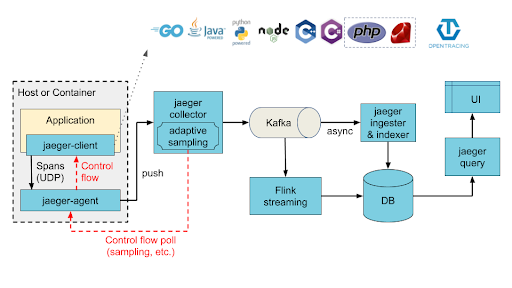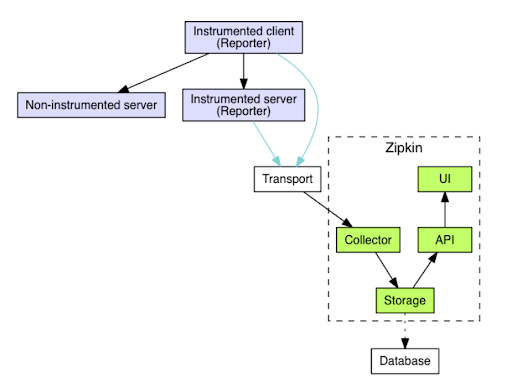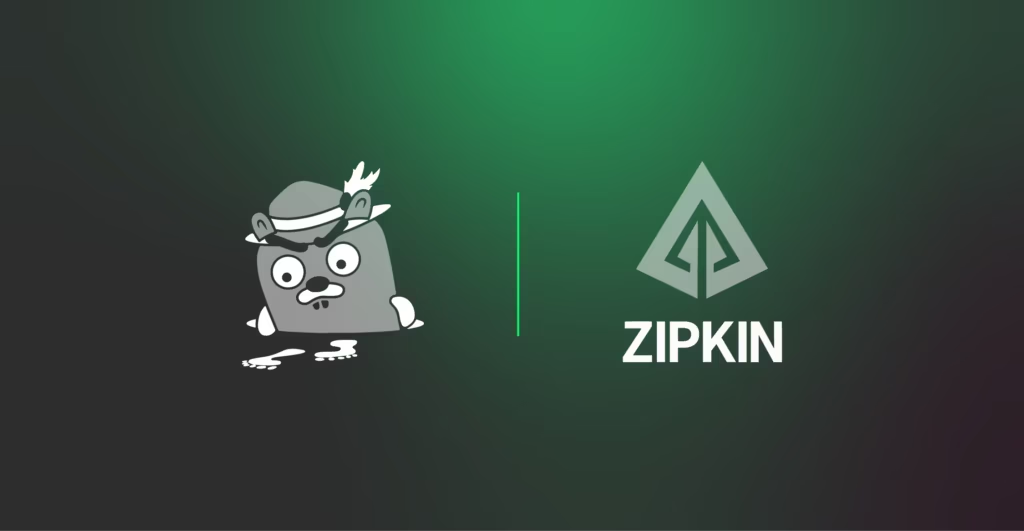Jaeger and Zipkin are both widely used open-source tools for distributed tracing, each with their own unique capabilities and functionalities. Zipkin, the pioneer of open-source distributed tracing, is a robust system designed for visualizing request data journeys, as they bounce between various services. It facilitates forensic investigations into your system infrastructure by giving users the ability to trace application flows without reconstructing them from scratch via log data.
Jaeger, on the other hand, specializes in monitoring and troubleshooting microservices-based systems. Jaeger supports distributed context propagation and transaction monitoring, making it invaluable for conducting root cause analyses, understanding service dependencies, and optimizing performance and latency.
While both tools offer significant strengths, they also have their own distinct weaknesses. This article provides a complete comparison between Jaeger tracing vs. Zipkin to help you choose the best tracing tool.
Key Takeaways
- Zipkin is built primarily in Java and offers a basic, easy-to-use setup.
- Advanced features like distributed context propagation and dependency analysis make Jaeger ideal for complex, large-scale environments.
- Jaeger supports the OpenTracing API, a vendor-neutral tracing standard that standardizes API instrumentation across tracing systems.
- Zipkin works with Spring Boot via Spring Cloud Sleuth, automating instrumentation and propagating trace and span across microservices.
- Jaeger, part of the Cloud Native Computing Foundation (CNCF), uses Kubernetes with Helm charts and templates in the incubator.
- Zipkin bundles the collector, storage, API, and UI into one process to simplify setup.
- Although Zipkin focuses on Java, community-supported instrumentation libraries exist for many other languages.
- GitHub metrics show that Jaeger and Zipkin are both extremely popular distributed tracing projects.
Complete Comparison of Jaeger vs Zipkin
Jaeger and Zipkin are two key distributed tracing systems developed to enhance monitoring and troubleshooting in microservices architectures. Both systems have advanced distributed system observability, helping organizations manage and troubleshoot their increasingly complex service networks.
Inspired by Dapper, Twitter developed Zipkin in 2010 and released it as an open-source tool in 2012. It is a distributed tracing system that diagnoses service network latency issues using timing data. Zipkin is built primarily in Java and offers a basic, easy-to-use setup that includes a collector, a database, and a UI for data visualization.
Uber developed Jaeger in 2015 to meet the demands of their extensive service-oriented architecture. Open-sourced in the same year, Jaeger is written in Go and supports various storage backends like Elasticsearch and Cassandra. It provides advanced features such as distributed context propagation and dependency analysis, making it well-suited for complex, large-scale environments.
When comparing Jaeger and Zipkin, there are several key aspects which impact their adoption and effectiveness in distributed tracing. Our comparison will cover the following aspects:
- Framework and library integration
- Deployment and operation
- Language support
- Strength of community
Here’s a summary table for points of comparison for Jaeger and Zipkin:
| Criteria | Jaeger | Zipkin |
|---|---|---|
| OpenTracing Compatibility | Yes | Yes |
| Storage Support | ElasticSearch, Cassandra, Kafka, and in-memory | MySQL, ElasticSearch, Cassandra, and in-memory |
| Framework and Library Integration | Leverages OpenTracing instrumentation libraries | Compatible with Spring Boot via Spring Cloud Sleuth |
| Deployment and Operation | Kubernetes and Docker | Docker images and Java programs |
| Language Support (Official) | C#, Go, Java, Node.js, C++, and Python | C#, Go, Java, Ruby, Scala, and Node.js |
| Community | CNCF-backed and supported by hundreds of open source contributors | Has an open-source community |
| Authors | Developed by Uber Engineering and accepted as a CNCF incubation project in 2017 | Originally developed by Twitter |
In the sections that follow, you will learn more about Jaeger and Zipkin tracing through an in-depth comparison of the two tools.
Framework and Library Integration
Both Jaeger and Zipkin are designed to integrate smoothly with popular frameworks. Jaeger aligns with the OpenTracing API, a vendor-neutral, open standard that ensures consistent API instrumentation across different tracing systems. This integration includes native libraries specifically tailored for certain frameworks. Jaeger employs OpenTracing libraries for instrumentation, allowing the use of various contributed projects.
Zipkin is compatible with Spring Boot via Spring Cloud Sleuth, which automates Spring Boot instrumentation and ensures trace and span propagation across any number of microservices. Additionally, Zipkin provides support for various other frameworks and libraries, enhancing its versatility in distributed tracing implementations. It lets the community instrument small libraries, such as database drivers.
Both tools support drop-in implementation for major frameworks, such as:
- Python’s Django
- Express.js
- Java’s Spring
Jaeger has a slight edge on the library instrumentation front, as it also uses the opentracing-contrib project to provide instrumentation for database libraries such as the AWS SDK, gRPC, and Thrift, in various languages.
Deployment and Operations
Zipkin and Jaeger both instrument trace data and send it to a collector, which then writes it to a data store. They support multiple storage backends, like Cassandra and Elasticsearch, and offer a query system through an API connected to a UI component. However, they differ significantly in their deployment strategies and system packaging.
Jaeger, as a part of the Cloud Native Computing Foundation (CNCF), primarily utilizes Kubernetes, with official Helm charts and templates available in its incubator. These tools deploy various components, including:
- Agent
- Collector
- query API
- UI
Moreover, Jaeger can be integrated with service proxies like Istio and Envoy, facilitating easier tracing across containerized environments. Here’s Jaeger’s architectural diagram:

Source: Jaeger
In contrast, Zipkin simplifies its setup by bundling the collector, storage, API, and UI into a single process. This approach allows for straightforward deployments using Docker images or Java programs, though it may require using the comprehensive deployment documentation that Jaeger provides. Users can also rely on Docker documentation, namely their deployment guidance README, which applies for any container orchestration system.
Here’s Zipkin’s architectural diagram:

Source: Zipkin
Both systems also accept Prometheus exported metrics to aid in monitoring. While maintaining the data store can be challenging, teams can use hosted solutions like Elasticsearch (which is generally more manageable than Cassandra). This choice offloads some responsibility but requires teams to carefully maintain their most critical infrastructure components.
Zipkin offers a more integrated and straightforward deployment experience. In contrast, Jaeger provides robust documentation and greater flexibility in scaling and managing distributed tracing systems.
Language Support
Jaeger maintains a wider range of languages than Zipkin. It also follows the OpenTracing standard, which enables simple integration with multiple libraries and frameworks.
Zipkin creates resources primarily for Java users, but community-supported instrumentation libraries exist for numerous other languages. Here is a table displaying the list of programming languages that Jaeger and Zipkin support:
| Language Programming | Jaeger | Zipkin |
|---|---|---|
| Official Languages | C#, Go, Java, JavaScript, Ruby, and Node.js | C#, Go, Java, Scala, and Node.js |
| Unofficial Languages (community-contributed) | C++, Python, PHP, Rust | PHP, Ruby |
Both tools have notable exceptions to the languages they support, such as PHP. However, Jaeger and Zipkin do not entirely lack support for these languages; they are unofficial clients, so proceed with caution.
While both Jaeger and Zipkin offer extensive language support, their differences can influence user choices:
- Community Contributions: Zipkin may have a slight edge in terms of the breadth of community-contributed libraries. This can be crucial for teams with less common programming languages or environments.
- Ease of Integration: Zipkin’s simple RESTful API makes it slightly easier to integrate with various languages and frameworks, and community contributions can be a welcome help during the integration process.
- Official Support vs. Community Support: Jaeger offers more robust official support for a slightly smaller set of languages compared to Zipkin. Users looking for more reliable or consistent updates might prefer Jaeger for the officially supported languages.
Both tracing systems benefit significantly from integrations that are tailor-made for specific programming languages, such as:
- Middleware for web frameworks
- Integration with logging libraries
- Modules for task queues
These integrations greatly simplify the process of incorporating tracing to existing application management processes. By tying them more closely to application-specific behaviors and patterns, tracing data can significantly enhance value.
Community
Jaeger and Zipkin are prominent open-source distributed tracing tools supported by robust community resources. Its community resources are designed to support both new and experienced users. Jaeger offers:
- Comprehensive documentation on its official website
- Active GitHub repository for code contributions and issue tracking
- Community mailing lists
- Gitter chatroom for real-time discussions
Similarly, Zipkin provides the following:
- Detailed documentation on its official website
- Well-maintained GitHub repository
- Gitter chatroom where users can interact with developers and other users
Furthermore, GitHub metrics confirm that Jaeger and Zipkin are both popular distributed tracing projects. Jaeger has a more extensive active contributor base, suggesting robust development and support. Despite having fewer contributors, Zipkin has higher engagement in terms of forks and stars, possibly indicating wider acceptance or use among developers.
The high number of open issues in Zipkin could be a point of concern or interest, depending on the context of those issues. Here’s a table summary for some GitHub metrics for Zipkin and Jaeger, implying community activeness:
| Insights | Zipkin | Jaeger |
|---|---|---|
| Contributors | 170 | 328 |
| Open Issues | 318 | 165 |
| Fork | 3.1k | 2.3k |
| GitHub Stars | 19.6k | 16.8k |
Side Note
In GitHub, a “fork” is a new repository, that shares code and visibility settings with the original “upstream” repository. “Commits” are changes or updates to a repository, each documented with an explanatory message. Together, forks and commits are key metrics that assess a project’s vitality and collaborative nature on GitHub.
Jaeger’s graduation from the Cloud Native Computing Foundation (CNCF) demonstrates how dynamic its community is, which is essential to its broad adoption and ongoing enhancement. Jaeger’s community includes developers, maintainers, and organizations dedicated to the project, contributing to its continuous improvements, extensive documentation, and robust support systems.
The Jaeger community offers members a dynamic support network and many ways to engage, seek help, and contribute to the project. Here are some ways users can participate in the Jaeger community:
CNCF Slack Workspace
The Jaeger community has a dedicated chat room, #jaeger, on the CNCF Slack workspace. This chat room offers a great starting point for new users to ask questions, seek advice, and connect with other community members. If you’re new to CNCF Slack, you can register at https://slack.cncf.io.
GitHub Issues
When you encounter a bug or have a suggestion for improving Jaeger, the community encourages you to open an issue on GitHub. The Jaeger project has multiple repositories under its GitHub organization.
GitHub Discussions and Stack Overflow
For questions that aren’t necessarily bugs or if you encounter problems and are unsure of their nature, the community recommends using GitHub Discussions or Stack Overflow. These platforms are suited for community support and problem-solving discussions, helping you get insights from community members and experienced Jaeger users.
Community Meetings
The Jaeger maintainers and contributors hold regular video calls every third Thursday of the month at 11 AM ET. These meetings are open to everyone and are an excellent opportunity to discuss issues, present case studies, and directly interact with Jaeger’s core team. The agenda and details for these meetings are typically available in a designated google doc, and meeting invitations can be found in their community calendar.
Zipkin’s platform functions independently, and doesn’t align with larger ecosystems like the CNCF. This standalone nature is not a drawback, but rather shows Zipkin’s adaptability and resilience. Over the years, Zipkin has cultivated a robust community that continues to support and expand, even as technology landscapes evolve.
Engaging with the Zipkin Community
Engagement with the Zipkin community can take various forms. Following @zipkinproject on Twitter is an effective way to keep aware of the latest updates, release announcements, and community events.
Gitter Platform
The Gitter platform serves as a space for real-time questions and discussions, allowing for more immediate and specific interactions. Developers have opportunities to contribute to several projects, including the main Zipkin server.
OpenZipkin Community
Volunteering forms the core of the OpenZipkin community, providing numerous avenues for involvement beyond coding. Engaging on Gitter often presents opportunities to assist newcomers with questions you might have previously encountered, offering a chance to give back to the community.
Local Meetups
Organizing or participating in local Zipkin meetups, such as the active group in Tokyo, is a fantastic way to meet and connect with other users face-to-face. This structured approach allows for a clear and thorough exploration of how to engage with and contribute to the Zipkin community.
Side Note
OpenZipkin is the OSS organization that stewards Zipkin code, documents, specs, and support. It includes Github projects, the Zipkin community website, Google groups, mailing list, Twitter, and Gitter.
Final Thoughts: Jaeger or Zipkin?
Jaeger and Zipkin are powerful distributed tracing tools with different strengths and weaknesses. Jaeger is an excellent tracing tool for large-scale, complex environments due to its advanced features like distributed context propagation and dependency analysis. It integrates well with CNCF and Kubernetes-supported modern infrastructure, making it ideal for detailed service monitoring in larger, dynamic systems. Zipkins is excellent for smaller projects or those using Java and Spring Boot because of its simplicity and setup. Though it lacks Jaeger’s advanced features, it supports many programming languages and has a simple deployment process.
When choosing a tracing tool, consider your service architecture’s scale and complexity, your team’s expertise, and the tool’s features that best meet project needs. Engaging with the community and understanding the specifics of each tool’s integration process into your existing tech stack will also help in deciding which works best for you.
FAQ for Jaeger vs Zipkin – The Complete Comparison
What are the limitations of Jaeger?
Jaeger primarily uses Go, potentially limiting accessibility for those unfamiliar with the language. Additionally, while its advanced architecture enhances performance, it can also complicate maintenance for your development team. Jaeger also uses in-memory storage, risking data loss without persistence, and lacks Zipkin API compatibility.
What are the limitations of Zipkin?
Zipkin’s centralized, less modular design can hinder speed and flexibility, impacting scalability in larger systems. Its core components are Java-based, aligning well with Java-centric organizations but potentially limiting otherwise.
What is the difference between Zipkin vs OpenTelemetry?
OTel enables vendor-agnostic observability with automatic instrumentation and flexible deployment. Zipkin, on the other hand, is a focused distributed tracing solution designed for HTTP-based communication, with manual instrumentation and limited integration possibilities.
Is Zipkin outdated?
Zipkin is still relevant, depending on the project’s scope and size. Zipkin is an open-source distributed tracing system that collects timing data to diagnose service architecture latency. However, Zipkin does have some features that have become fully deprecated, like its ‘custom server’ feature.






